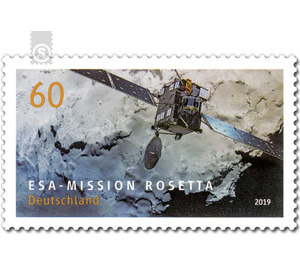Series "Astrophysics" - ESA-Mission Rosetta - Germany / Federal Republic of Germany 2019 - 60 Euro Cent
Theme: Astronomy & Space
| Country | Germany / Federal Republic of Germany |
| Issue Date | 2019 |
| Face Value | 60.00 |
| Color | grey blue |
| Printing Type | Multicolor offset printing |
| Stamp Type | Commemorative |
| Item Type | Stamp |
| SID | 706771 |
| Dimensions | 44.00 x 26.00 |
| In 32 Wishlists | |
Astronomers have long suspected that comets contain complex organic carbon compounds - the basic building blocks of life. But unlike Earth, which has been changing its face ever since its creation, the wanderers between the worlds have remained unchanged for 4.6 billion years. Now and then, such a celestial body is thrown off its tracks and makes its way through space. A probe from the European Space Agency (ESA) has accompanied the comet Tschurjumow-Gerasimenko, or Tschuri, for more than two years as he approached the sun. The Rosetta probe, which was built in Friedrichshafen on Lake Constance, started on 2 March 2004 with the Ariane 5 launcher from the Kourou Space Center in French Guiana. The missile was conducted by the European Space Operations Center (ESOC) in Darmstadt. Rosetta reached the orbit of the unusual, like a rubber duck, formed comet in August 2014. Thanks to a spectacular landing of the landing unit Philae, the researchers could even even set off a small laboratory on it. The measured data and impressive photos answered some questions, but also surprised the scientists. Until then, the imaginative structures were referred to as dirty snowballs. Instead, on Tschuri there are four times as much dust as ice. In addition, the team from the Rosetta mission discovered a molecule that was unlikely to be: oxygen, as it occurs in the atmosphere of our planet. In the course of its two-year mission, the OSIRIS camera installed on the spacecraft took more than 60,000 photos before the scientists targeted Rosetta on the comet on September 30, 2016. The evaluation of the extensive data will take many years and bring so much knowledge. The excursion to Chury already prepared the next mission: Next time a piece of a comet is to be brought to earth.


